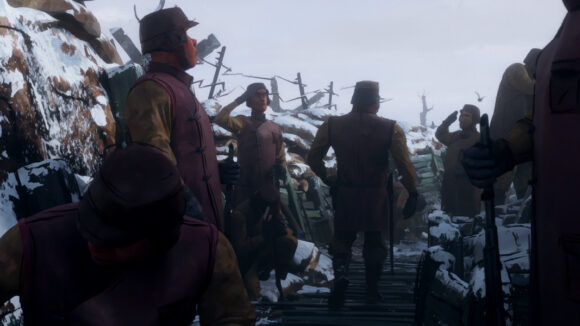

Oscar Shortlist Interviews: Director Dave Mullins Shares His Favorite Shot From ‘War Is Over!’ (Exclusive)
We invited the filmmakers behind each of this year’s 15 Oscar-shortlisted animated shorts to share their favorite shot from their film and explain why it’s special to them. The pieces are being published in the order that materials were received.
In this piece, we’re looking at War is Over! Inspired by the Music of John and Yoko from filmmaker Dave Mullins, who previously received an animated short Oscar nomination for directing the Disney-Pixar film Lou.
War is Over! is set in an alternate WWI reality, in which two soldiers on opposite sides of the conflict play a game of chess. Overhead, a carrier pigeon delivers the soldiers’ moves from trench to trench as the fighting wages on.
Below Mullins shares his favorite scene from the short and tells us its significance:
This is the first shot that I could see in my mind when writing the script for War is Over!. With John and Yoko’s anti-war message being the entire reason for making this film, I wanted a shot early on that represented that message from an emotional point of view. I also wanted it to be a touchstone for other shots stylistically and signal the audience what type of film they’re about to watch. For me, this shot is an homage to my favorite filmmakers – Hayao Miyazaki, Ridley Scott, and Stanley Kubrick, among others. It’s this type of visual language that makes their films so engaging and re-watchable.
One way to make a shot like this really stand out is by combining two primal elements on screen, which is meant to evoke a gut-level emotional response from the audience. It’s like a filmmaking haiku. A simple example of this is when you see a burnt-out car. The combination: car and fire. You immediately know what happened. The story is obvious to anyone in any language. It’s visual.
For War is Over!, we used blood and snow as our two primal elements. The shot starts on freshly fallen snow; the Sergeant steps through the frame, leaving behind a boot print that fills with blood. You quickly get a sense of how long the war has been raging on and the soldiers’ situation. Those two combined elements give us a lot of information.
We also wanted to quickly establish a sense of the relationship between the Sergeant and his soldiers. Chain of command is very important to the film. We needed to illustrate the suffering and the terrible situation they are living in. It is bone-chillingly cold; snow is falling, mixed with a frozen mist.
We designed the combination of those elements to deliver depth and atmosphere within the shot, skillfully crafted by our production designer, Zac Retz, and visual effects supervisor Keith Miller’s team at Wētā FX.
From a camera and performance standpoint, I worked out the shot with our director of photography, Antonio Riestra, on stage. Then, we continued to develop the look of the shot at Wētā FX with Aidan Martin (animation supervisor) and David Scott (digital director of photography), who worked closely with me to make these multiple elements work together.
Finally, with the elements layered in, we see our hero pigeon flying low near the trench and the soldiers, intimately connected to the war activity. We made a choice to clearly declare that she isn’t above the conflict; she’s part of it.
It is a lot to pack into one shot, but in less than 8 seconds, we introduce the war, the harsh environment, the Sergeant and soldiers, the chain of command, the pigeon’s role in the war, and the hell they are all living in. All of it paints a picture of the human condition and its place within the horrors of war.
With everything going on in the world today, we really wanted to get this messaging correct, both from an emotional and visual point of view. Although a shot like this really focuses on the hell of war, we hope the audience leaves the theater really feeling John and Yoko’s message of peace that they sang so passionately about over 50 years ago.
Read the other entries in the series:
- John Musker on I’m Hip
- Flóra Anna Buda on 27
- Tal Kantor on Letter To a Pig
- Bret Parker on Pete
- Yegane Moghaddam on Our Uniform
- Karni Arieli and Saul Freed on Wild Summon
- Rita Basulto on Humo
- Jared and Jerusha Hess on Ninety-Five Senses
- Stephen Vuillemin on A Kind Of Testament
- Gabriel Augerai, Romain Augier, and Yannick Jacquin on Boom
- Priit Tender on Dog Apartment
- Stéphanie Clément on Pachyderme
- Lucija Mrzljak and Morten Tšinakov on Eeva
- Dan Abraham and Trent Correy on Once Upon a Studio

.png)